As much as we love a good story about that Eureka! moment, big inventions don't really come out of thin air—or appear at exactly one moment in time.
Carl Benz (aka Karl Benz) is widely known for inventing the first gasoline-powered car, but there were already buggies and combustion engines around. So you'll often see him credited as the inventor of "the first practical automobile," which is of course quite a bit different than "the very first person to make some kind of carriage move with an engine."
Who deserves credit for inventing the electric guitar? Well, the answer is similarly complicated.
Like Benz’s car, the electric guitar as we know it today was not a single invention, but the result of an evolution. It emerged thanks to the advent of amplified sound, the changing demands of musicians, and marketplace competition. There were simultaneous inventions. There were false starts. There were many possible paths of the electric guitar not taken.
"Who invented the electric guitar?" is perhaps not even the right question. Let's look instead at who contributed to its development.
George Breed's Electrified Guitar
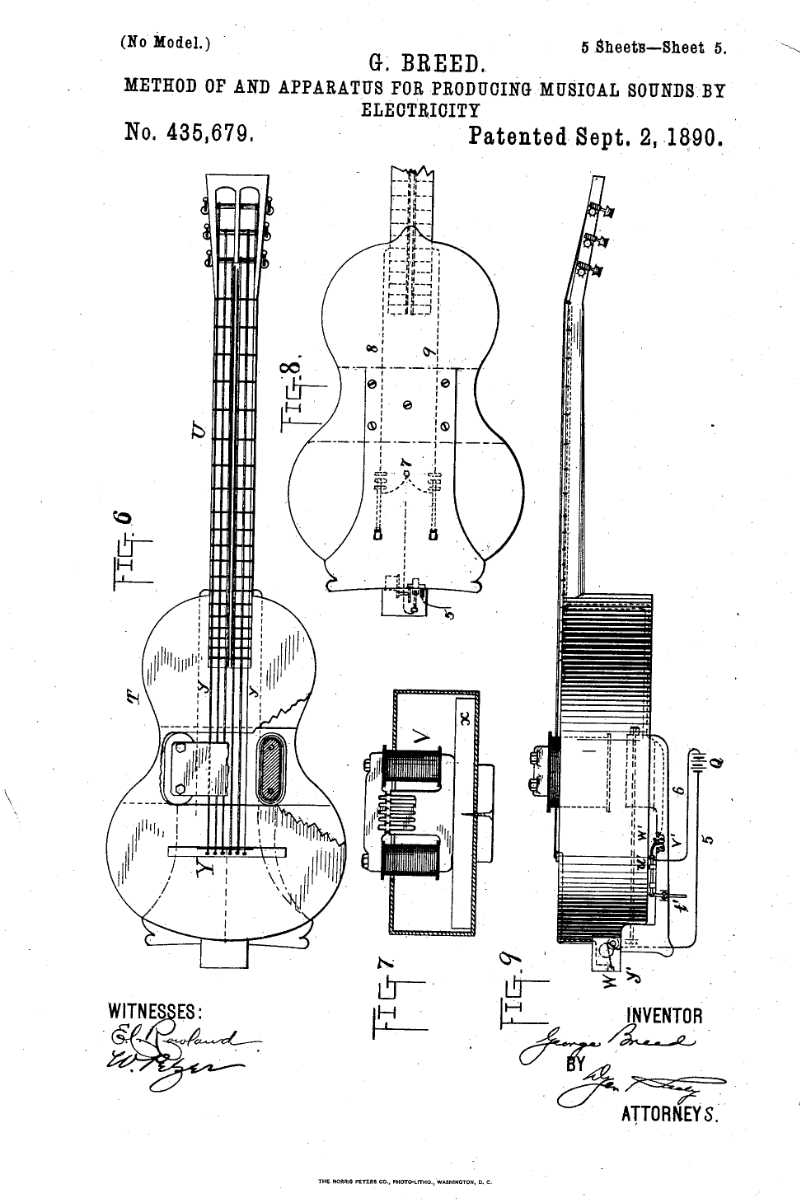
Way back in 1890, a US Navy officer named George Breed was granted a patent for his "Method of and apparatus for producing musical sounds by electricity." At first glance, this "apparatus" may look something like a modern pickup. However, while it did combine electricity with a fretted musical instrument, it did so in a very different way than what we're used to now.
Breed's invention could be attached to a standard acoustic guitar of his time (though to work, it would have to have metal strings, which were uncommon at the time). Notably, as other pages of his patent application show, Breed thought the device could also be used with a keyboard or, non-musically, as part of a telegraph system. That's because Breed's pickup-looking invention used electromagnetism to vibrate strings, not to pick up the strings' vibrations and transmit them to an amplifier.
This means that, so far as Breed's guitar was "electrified," the amplification of its tones would have still relied on the acoustic soundboard. His invention was more like a heavy, multi-string EBow strapped onto an acoustic guitar.
Matthew W. Hill is a historian of early electric instruments who knows as much about Breed and his invention as there is to know. His 2013 paper, "George Beauchamp and the rise of the electric guitar up to 1939", has many more details on Breed's device. Hill has also recreated Breed's design and made audio recordings of it, one example of which you can hear at his website organology.org.
A Brief Detour Through Amplified Sound
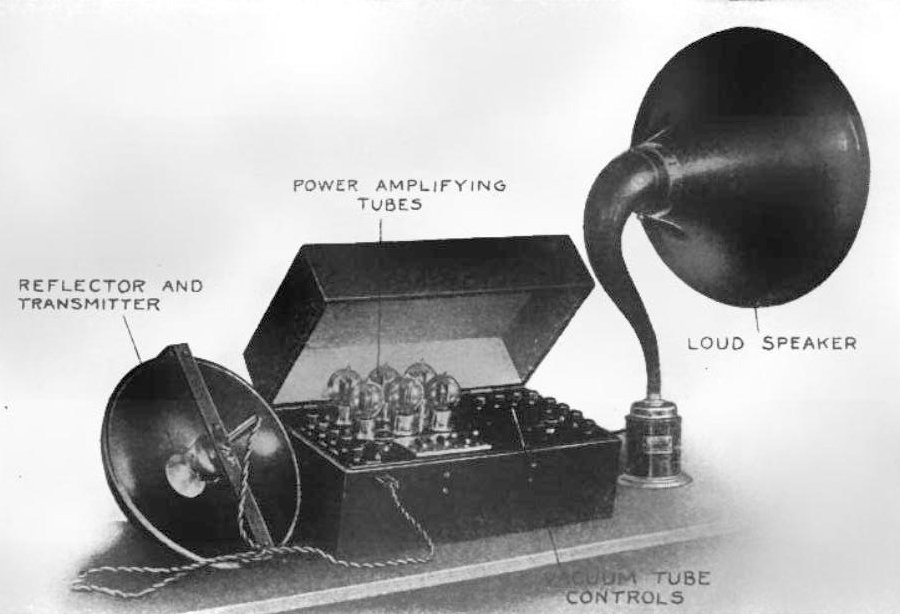
Before we discuss any further the development of the electric guitar, let's pause to consider a basic fact. If a true electric guitar is one that turns its vibrations into electrical signals in order to have them amplified through a speaker, amplified speakers would need to be invented first. And indeed they were.
Various loudspeaker designs had been employed ever since the telephone's development in the 1860s, '70s, and '80s, growing from those small origins into public address systems. But even then-advanced speakers like the ones installed in Chicago's Comiskey Park in 1913 were a far cry from a modern system.
From 1915 through 1919, the pair of inventors that founded Magnavox created the first speaker systems that used vacuum tubes to amplify electrical signals. While their design used the earliest Audion tubes, which were weaker than the kind RCA and others made later, it set the stage for amplifiers to come, and Magnavox continued to refine its tube amp design to produce PA systems, phonograph speakers, and radio sets.
Soon after, Magnavox's Peter Jensen invented the paper cone speaker in 1927, under his own brand. (And yes, that is the same "Jensen" name you may recognize from the beloved speakers found in vintage Fender, Ampeg, and Gibson amps.)
Stromberg-Voisinet's "Electro" Line

With amplified voices, amplified records, and amplified radio broadcasts growing louder and louder throughout the 1920s, acoustic instruments had to catch up. Stromberg-Voisinet was one of the first to announce pickup-equipped stringed instruments, along with a combination amplifier-and-speaker made for them, all documented in the October, 20, 1928 issue of The Music Trades magazine. A company promo from early 1929 advertised that the "Electro Instruments" line featured a mandolin, banjos, tenor guitar, and guitar.
As George Gruhn and Walter Carter quote in Electric Guitars and Basses: A Photographic History, the 1928 Music Trades article explained: "The electro-magnetic pickup operates to convert the mechanical vibrations of the bridge or sound board to electrical impulses. These, in turn, are amplified, thereby increasing the tone of the instrument as many times as desired."
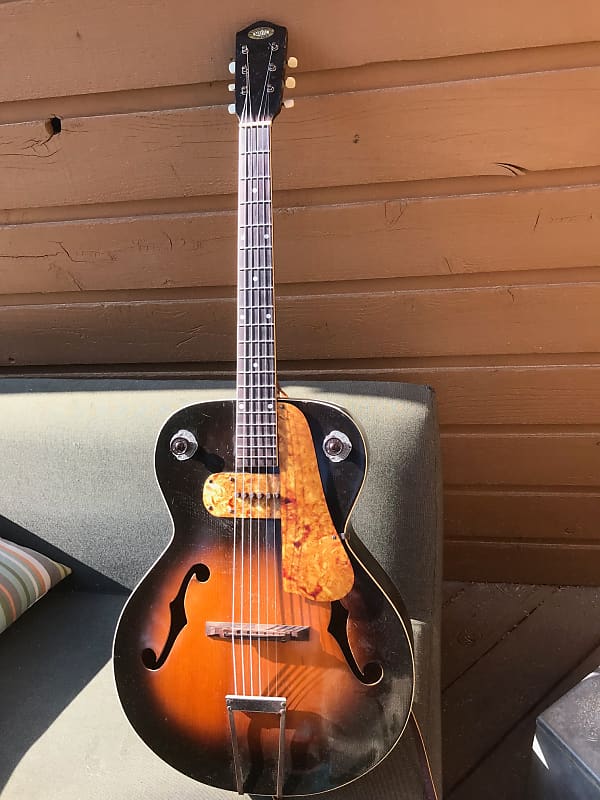
Compared to Breed's earlier guitar, this is starting to sound something like a modern electric. However, as historian, collector, and early electric expert Lynn Wheelwright notes in his book The Pinecaster Volume 1: The Pioneers, there's reason to believe Stromberg-Voisinet's Electro Instruments never got past the prototyping stage, as there are no complete surviving examples. (Wheelwright has documented in a Vintage Guitar article a circa-1928 Stromberg Electro pickup, which had been built into a later Kay guitar.)
Soon after Stromberg-Voisinet's Electro announcements, the Great Depression arrived, which would have been a good reason to delay any expansion into a new realm of musical instruments. Stromberg-Voisinet became Kay in 1930/1931, which wouldn't market its own electric gear until 1936, starting with the Kay Electric Unit piezo pickups, which players could place on their own acoustics. Arriving around 1938, the Kay-made Oahu Electric Spanish had an electromagnetic, six-pole pickup built in near the neck.
George Beauchamp's Revolutionary Pickup
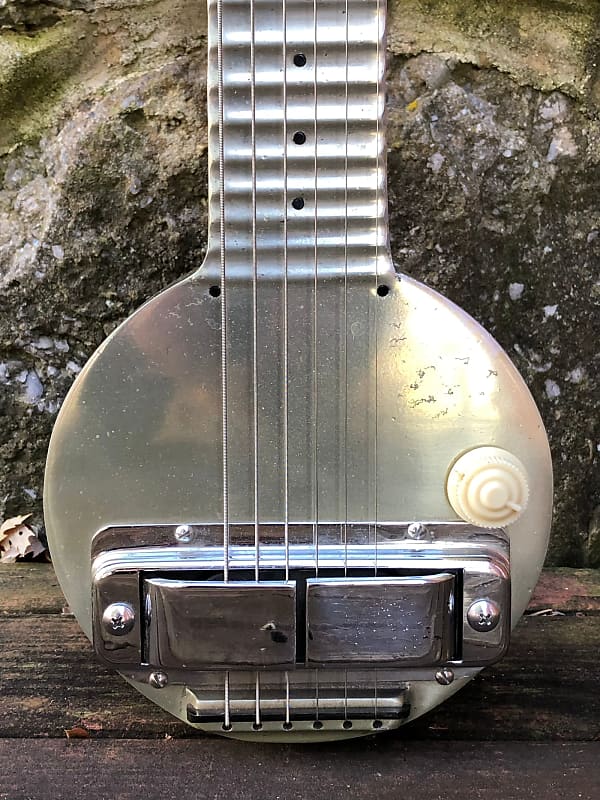
Swiss immigrant Adolph Rickenbacker (née Rickenbacher) was a tool-and-die maker who set up shop in Los Angeles in 1925. The National String Instrument Corporation was one of his customers, and eventually engaged Adolph to make metal bodies for its resonator guitars.
At the time, there was drama afoot at National. Founding partner George Beauchamp (pronounced BEE–chum) had clashed with the company over its refusal to develop electric guitars, despite the fact that he had been making serious progress on the technology.
Beauchamp played Hawaiian guitar. And it's worth pointing out here that he was very much not alone. In the early 20th century, after the United States annexed Hawaii, the Hawaiian style of guitar-playing—guitar on the lap, strings tuned to a chord, steel bar in hand—traveled from the island of Oahu across the continental US, becoming a popular music craze that lasted decades.
Many players, like Beauchamp, wanted their acoustic steel guitars to be louder, to be able to heard above a band. It was the same volume issue he had tried to solve earlier with National's John Dopyera, who invented the metal-bodied resonator guitar with some assistance and a lot of encouragement from Beauchamp.
When Beauchamp set about creating an electric Hawaiian guitar, he toyed with pickup designs, finally arriving at an over-the-strings pickup with two horseshoe-shaped magnets surrounding a coil of wire. That wire surrounded six smaller magnets, one for each string. This was a giant leap toward the modern pickup as we know it today.
While competing pickups at the time sought to transfer string vibrations from the bridge or soundboard to a separate rod, which would then disturb a magnetic field, Beauchamp's design used the strings themselves to accomplish the feat. He essentially cut the messenger out of the design, in a way that all modern guitarists can recognize: As long as the strings you use are metal and ferrous (aka magnetic), the pickup captures their movements directly.
The design sacrificed natural acoustic tone—a major sticking point for manufacturers like National, Gibson, and Dobro—but solved the need for greater volume. Acceptance among musicians and listeners would prove to be slow but sure.
Beauchamp, Rickenbacker, and others severed ties with National and joined forces to form the Ro-Pat-In Corporation. They made a solid wood prototype with Beauchamp's horseshoe pickup in 1932, which became known as the "frying pan" because of its shape. They then produced many commercial frying pan lap steels, using Rickenbacker's hollow aluminum bodies. (That same year, they made a prototype of an electric Spanish guitar with the same pickup.)
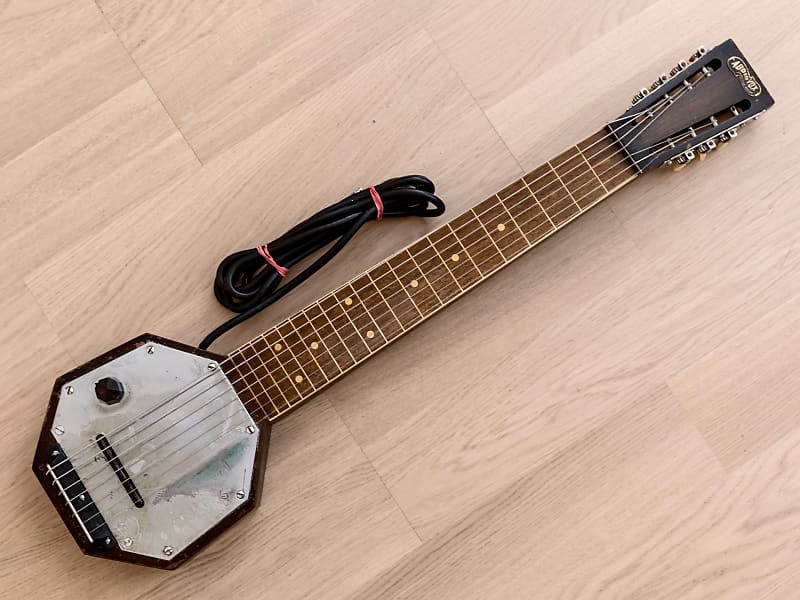
Coming out of production, the frying pan was available in two models with different scale lengths: the A22 and A25, selling the first models under the brand name Electro. They changed the company name to Electro String Instrumental Corporation in 1934 and marketed the guitars as Rickenbacher Electro Instruments, and so (after a subtle spelling change) the storied Rickenbacker brand was born.
In 1935, Electro String followed up the A22 and A25 with the Model B, which came in a square-neck lap steel version and a round-neck Spanish version. The success of Electro's frying pan guitars led to many competitors, like Seattle's Paul Tutmarc and his AudioVox company. In the mid-'30s, he created an octagonal-take on the frying pan. And in 1935, he invented and sold what is inarguably the first electric bass guitar.
ViVi-Tone and Lloyd Loar's Gibson Electric Lore

While he only worked at Gibson for five years, from 1919 to 1924, Lloyd Loar's tenure there is renowned. He is best-known for introducing violin-like construction—for example, f-holes—to Gibson's mandolins and archtop guitars. The F-5 mandolin and L-5 guitar he designed before he left Gibson in 1924 are some of the most prized from that era (or, in the case of the F-5, the most prized from any era).
There is a myth (repeated in an earlier version of this article), that he also built prototypes of electric instruments while at Gibson, and that the company's refusal to produce them was one of his reasons for quitting. But as documented by Gruhn, Carter, Wheelwright, and Hill, there is no evidence that this actually happened.
That said, in 1932, Loar co-founded ViVi-Tone, an instrument company that did make expressly electric stringed instruments. Wheelwright notes that Loar's "solid, plank-body designs, although fairly common today, were radical for the period."
As ViVi-Tone brought its ideas to market, the company dressed up Loar's skeletal frames and pickup platforms with hollow bodies in more conventional shapes. Some such designs featured a pull-out drawer that housed the pickup. Others gave players the option to move the bridge away from the pickup in order to play wholly acoustically.
However, the electrostatic pickup at the heart of ViVi-Tone's instruments required more amplification than the electromagnetic designs of Beauchamp and other companies, and soon became an also-ran in the race for power and volume.
Gibson's First Electrics
Loar's former employers at Gibson swiftly followed in the electric footsteps. In the early '30s, Gibson was building its famous archtop acoustics and dreadnought flat tops to compete with Martin and Epiphone. In 1935, Gibson released the E-150, a metal-bodied lap steel designed to compete with the Frying Pan.
In 1936, Gibson more gamely introduced its first electric hollowbody guitar. It was the EH-150 custom, with $150 being the combined cost of the guitar and a companion Lyon & Healey amplifier.


Gibson E-150 Lap Steel
That same year, Gibson introduced its first ES or “Electric Spanish" model: the ES-150, a hollowbody with f-holes, a bar pickup later known as the “Charlie Christian" type, and two controls.
Through general manager Gary Hart, Gibson had by then applied for a patent on an under-the-strings pickup so as not to compete with Adolf Rickenbacker’s over-the-string patent.
Gibson ES-150
Paul Bigsby and Merle Travis

Merle Travis
In 1947, musician Merle Travis commissioned Paul A. Bigsby to build a solidbody electric guitar. Collaborating on the design, they created a gorgeous instrument with a birdseye maple body, neck-through construction, and tasteful wood inlays and ornamentations.
The Bigsby-Travis guitar presaged later electric designs with its sleek body, a single cutaway (like Gibson’s Les Paul, which came five years later), and a headstock with all six tuners on one side. Bigsby’s original components included a fixed bridge made of cast aluminum and a handmade single–blade pickup.
As vintage experts Gruhn and Carter note in their book, Bigsby would probably be known today as the father of the electric solidbody had he gone into production with this guitar, but he made only a handful.
Instead, Bigsby is considered the father of the modern pedal steel, and his name has adorned tailpiece vibrato units since the 1950s.
Leo Fender's First Solidbodies
By the time Leo Fender was first fleshing out solidbody electric designs around 1943 or ‘44, the first wave of electrified stringed instruments had already come. But progress in design and manufacturing had slowed down with the onslaught of WWII.
But Leo’s vision was not to simply build a solidbody electric guitar, but mass produce one. Whereas prior developments left manufacturers all but apologetic for not reproducing authentic acoustic tone, Fender embraced the new sound and sought a clean, amplified version of a string resonating on a solidbody.

1953 Fender Esquire
After forming the K&F company in the mid 1940s (with Doc Kauffman, who previously had a hand designing Rickenbacker Electros), Leo founded the Fender Electric Instrument Company in 1946.
Fender was joined by George Fullerton in 1948, and the pair bucked tradition with simple, reliable, and reproducible solidbody electrics made from slabs of ash. The single-pickup Esquire was released in 1950 with the double-pickup version, the Broadcaster, following later that year. These became the world’s first commercially successful solidbody electric guitars.
The Broadcaster was renamed the Telecaster shortly after its launch and is still in production nearly seven decades later.
Les Paul's Experiments
As a 12-year-old kid around 1927, budding guitarist and relentless tinkerer Les Paul had an idea. He stuck the pickup from a record player inside his acoustic guitar, placed a telephone’s mouthpiece under the strings, and wired them both to his parents’ radio to function as an amp-speaker combo.
Then, stuffing rags into his acoustic to control the pickup’s microphonics, he started thinking about a solidbody model.
Around 1939, Les started work on a solid electric prototype—a real Frankenstein object—later to be known semi-affectionately as “The Log."
A solid block of pine formed the narrow center section of the Log's body. The pickups were screwed into a bridge and had covers made from old clock parts. It had a tailpiece and a crude vibrato.
Les Paul joined the big block of pine to a neck he had pulled off of a Gibson L-series model and used the sides from an Epiphone to add the “wings," a cosmetic choice to create the waisted shape of a guitar.
Paul took his Log to Gibson in 1941, and the story goes that they laughed him off. But Gibson came back to him in the early 1950s when it decided it needed some competition for Fender’s new Broadcaster and Precision bass. In 1951, Gibson signed a deal to tag Les Paul’s name on their elegant new solidbodies (mostly designed by Gibson's Ted McCarty, despite Paul telling quite a few tales otherwise). The Gibson Les Paul “Goldtop" was released in 1952.
Editor's note: This article was originally published in 2017. We've updated the piece substantially, incorporating feedback received from readers.



